Letters from Lodi
An insightful and objective look at viticulture and winemaking from the Lodi
Appellation and the growers and vintners behind these crafts. Told from the
perspective of multi-award winning wine journalist, Randy Caparoso.
National Zinfandel Day Technical Workshop takes a keen, sobering look at the future of Lodi Zinfandel
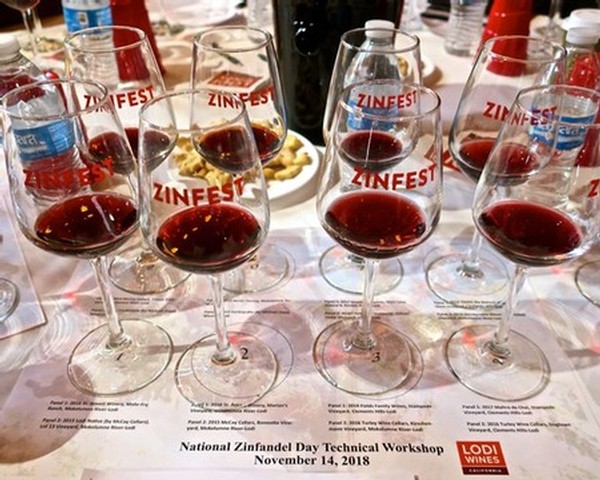
To kick off 2018’s National Zinfandel Day week, this past November 14, over 100 winemakers and growers came together from both inside and outside the Lodi AVA for a Technical Workshop co-sponsored by the Lodi Winegrape Commission and ZAP (Zinfandel Advocates & Producers). This educational industry event took place in Oak Farm Vineyards’ historic redwood barn, built in 1864.
On the agenda were two 4-man panels – one representing “Growers’ Perspectives,” and the other “Winemakers’ Perspectives” – who addressed the current and future state of Lodi grown Zinfandel. Particularly, exactly what steps can be taken to save many of Lodi’s venerated old vine Zinfandel plantings, now in danger of disappearing as a result of the recent market plunge of both White Zinfandel and value priced red Zinfandels ($10 and under). Each panelist also presented two Zinfandel bottlings representing what they grow or produce.
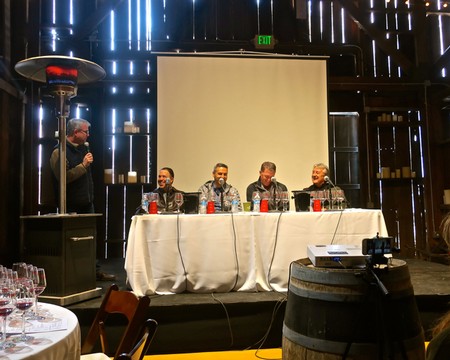
Zinfandel Workshop (from left) moderator Stuart Spencer with panelists Bruce Fry, Jeff Perlegos, Keith Watts and Markus Bokisch
Lodi Winegrape Commission Executive Director (as well as St. Amant Winery winemaker/owner) Stuart Spencer kicked off the proceedings by reminding the audience of vintners and growers: “Zinfandel has a place in the hearts and minds of the Lodi community. Most of it is grown by independent growers who have been farming their vineyards for generations – something you don’t see as much anywhere else in the world, except in Lodi.
“Our goal is to keep these vineyards for generations to come by connecting them with winemakers across California and in other states, and find these grapes a home. We also know that, with the cost of farming today, these vineyards probably need to go into more premium priced wines.
“The four growers on our panel today have been particularly successful in connecting their vineyards with winemakers because they have been able to tell the story of their old vine vineyards, and communicate the value and quality of their product to winemakers willing to pay for those grapes.”
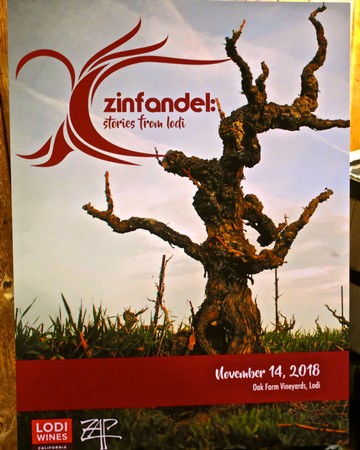
Excerpts from the panel discussions, along with notes on the Zinfandels presented by each of the eight panelists:
Growers’ Perspectives: What It Takes to Sell Zinfandel Fruit
Bruce Fry (Mohr-Fry Ranches):
“Our family has been farming in California since 1855, and we have been here in Lodi since 1965. I am a fifth generation California farmer, and our operation continues to be family run. Right now we farm about 600 acres on five different properties in the Mokelumne River-Lodi appellation. On average we sell to about 25 wineries; out of that, about 11 different Zinfandel buyers from two zin properties. Our home property on West Lane has 8 different blocks of Zinfandel, ranging from 5 acres to 15 acres. Marian’s Vineyard, planted in 1901, is the oldest, and the rest date back to the 1940s. All these vineyards are own-rooted, on sub-surface irrigation.
“How do we sell these grapes, market them, and find people to buy them? Around 1994 we began custom crushing and selling wine from these grapes on the bulk market. Once we got our license to do custom crushing, we drove up and down the coast showing potential buyers what our grapes can do. We also tried to over-deliver on logistics. We have a certified scale and are able to deliver in macro-bins or whatever which way wineries need it to be handled. We also over-deliver on quality. If they ask for X, we give them XX; which is hard to do since every year we also deal with Mother Nature, but you try. Communication is key – telling buyers what’s going on in the vineyard, how’s the crop level, the disease pressures.
“’Telling your story’ is all about branding. We constantly tell our story of who we are, where we’ve been, and the uniqueness of each individual block. We were among the first to farm in the LODI RULES (for Sustainable Winegrowing) program, which started in 2005. All of our Zinfandel vineyards have been certified ever since. Our Zinfandel blocks are registered by the Historic Vineyard Society – the Mohr-Fry Ranch blocks and Marian’s Vineyard separately. We have also trademarked our Mohr-Fry Ranch name.
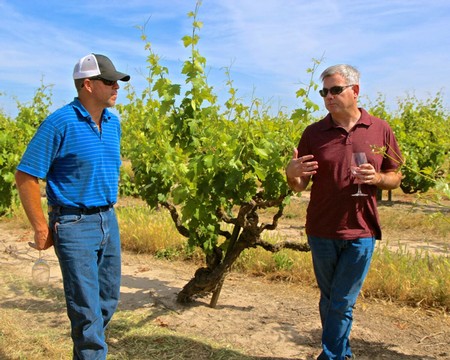
Bruce Fry (left) and Stuart Spencer in Mohr-Fry Ranches' Marian's Vineyard
“Farmscaping and signage, marking our Historic Vineyard Society blocks, around the vineyard are just as important: making sure your vineyard is clean and neat, with roses planted at the end of rows along the road. We’re often asked why there are roses. Well, because it looks nice!
“Finding buyers is the first step. Then we ask our wineries to vineyard-designate our wines. Of course, you have to give them a reason for it by communicating the uniqueness of your property and the story behind it. Between the vineyard-designate bottlings by wineries like St. Amant, Oak Farm, St. Jorge, Macchia, Chouinard and other wineries, we are able to demonstrate the quality of our Zinfandel to potential buyers. They may all have varied winemaking, but they share a common lineage, and show the quality of the place.
“We’ve been taking the time to market ourselves since 1995. It’s an idea my dad (Jerry Fry) originally got from Robert Young, who did that with his Sonoma County Chardonnay. My dad got to know Robert Young really well through CAWG (California Association of Winegrape Growers). It set a good example of what anyone can do with Lodi grapes. When people think of Lodi, we want them to think of Zinfandel from Mohr-Fry Ranches; and when they think of that, they think of Lodi.
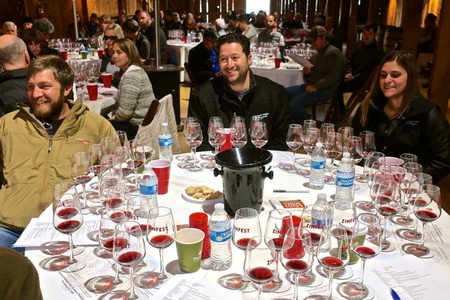
Oak Farm Vineyards proprietor Dan Panella (center) during National Zinfandel Workshop in Oak Farms' 154-year-old barn
“The Zinfandel from Marian’s Vineyard, planted in 1901, grows bunches that are distinctly more elongated compared to our 1940s blocks. The vines have more vigor and produce more fruit, and still gets 3, 4 tons depending on the year. That’s the mystery of old vine Zinfandel. We have no idea of where the wood originally came from. They (the Mettler family, in 1901) just stuck the cuttings into the ground, and they’ve continued to grow in their own unique style, and it makes our best and most unique Zinfandel.”
2016 St. Amant Winery, Mohr-Fry Ranch Mokelumne River-Lodi Zinfandel ($18) – From the Fry family’s Block 416 off West Lane; nose of red berries, soft leather and loamy earth; medium-full, firm, compact feel.
2016 St. Amant Winery, Marian’s Vineyard Mokelumne River-Lodi Zinfandel ($24) – Red berry nose with floral and cedary notes; sense of size in its medium-full body, yet zesty, silky, long and buoyant on the palate.
Added Stuart Spencer, who crafted the St. Amant wines: “As winemakers, our goal is not to screw up the quality of the grapes we get from Mohr-Fry. Our relationship with the Fry family was sealed in the mid-‘90s, when our own vineyards in Amador County were dying of phylloxera, and my dad (the late Tim Spencer) was looking to supplement our St. Amant Winery production with Lodi grapes with 1 or 2 tons here or there.
“In typical Lodi fashion, one day Jerry Fry showed up with 7 tons of Zinfandel. He had started on a block, then decided to pick through the entire block. My dad was totally freaked out – he couldn’t figure out how he was going to pay for it. Jerry said, ‘Don’t worry about it, just make the wine and we’ll see what happens.’ We made the wine and it turned out beautifully, so we bottled it as a vineyard-designate (Marian’s Vineyard) in 1996. It won a bunch of awards and sold out within a few months. We’ve continued with that ever since, and now it’s our largest production wine.”
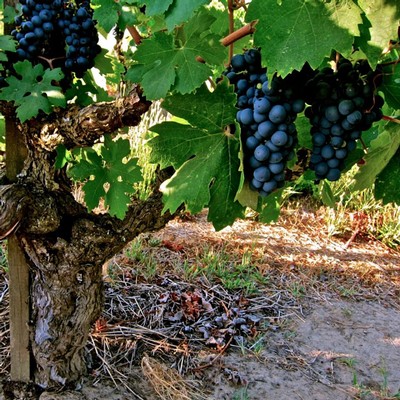
Marian's Vineyard Zinfandel, planted 1901
Jeff Perlegos (Stampede Vineyard):
“I am a second-generation Lodi grower. My parents came from Greece some time ago, began a business in town (Lodi), then bought some land where they planted Tokay and Zinfandel. We farm about 50 acres, including 22 acres of grapes and Bing cherries on the west side of town.
“We added Stampede Vineyard in December 2012. It’s a 20-acre old vine Zinfandel vineyard, located east of town, in Clements. Everything we do with Stampede we do with the thought, ‘What would a winemaker want?’ We’re wine lovers, and so everything we do is done with that in mind.
“The 2014 Fields Family Stampede Zinfandel was produced by our first customer, after we bought Stampede. Our vineyards typically give anywhere from 22° to 25° Brix (i.e. sugar reading), but our pH is consistently quite low, about 3.2, 3.3. The vineyard characteristically produces higher acid grapes. Part of the reason is because we really watch our irrigation and potassium – part of our philosophy of maintaining the vineyard in the way that our winemakers prefer. Besides Fields Family, this includes Bedrock Wine Co. and Maître de Chai.
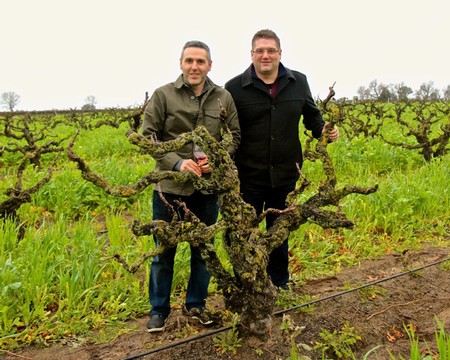
Jeff and John Perlegos in their Stampede Vineyard
“I like to over-communicate with our winery/partners. If they come out, I want to be there to walk the vineyard so that we can plan on what to do together. Our decisions and timing have evolved as we came to know both the vineyard and our winemakers better.
“Stampede is basically halfway between here (Lodi) and Amador County. We tend to get characteristics in the wine typifying both counties. It’s makes a pretty high structure wine – its color, density and tannin is more like a mountain grown Zinfandel.
“The Maître de Chai Zinfandels have consistently been made from one particular part of the vineyard each year. They prefer the least vigorous portion, and their winemaking involves native yeast fermentation and use of whole cluster. Overall, Stampede Vineyard Zinfandels have been very fresh styles of the grape. Both of the wines we are showing today are pretty low in alcohol – closer to the 12% to 13% range – showing that we really don’t have to get the grapes really ripe to make a fine quality Zinfandel.
2014 Fields Family Wines, Stampede Vineyard Clements Hills-Lodi Zinfandel ($28) – Ultra-fresh, exuberant red berry/cherry nose; sleek medium body buttoned down with zesty acid and fine grained tannin, finishing with savory, red licorice notes.
2017 Maître de Chai, Stampede Vineyard Clements Hills-Lodi Zinfandel ($33) – Youthfully tight yet bright, effusive red cherry nose with subtle cedary flourish; firm and zesty feel to cherryish fruit spiced up with pepperminty herbiness towards the finish.
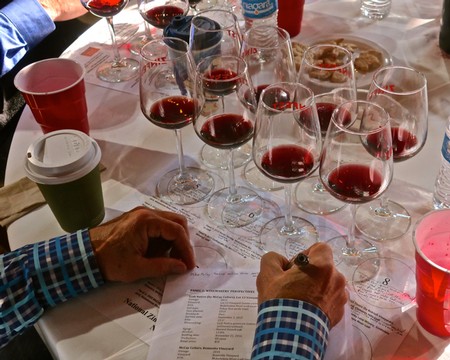
Taking notes during National Zinfandel Day Technical Workshop
Keith Watts (Keith Watts Vineyards/TruLux Vineyard):
“I am a third generation Lodi grower. We farm 800 acres, including about 100 total acres of Zinfandel – some on wire, and older ones that are head trained and can’t be irrigated very much without effecting fruit quality. In 1999 my father started Watts Winery, which my brother (Craig Watts) has since taken over. That’s when we first started producing our first vineyard-designate Zinfandel (Watts Winery’s Pescador Vineyard Zinfandel; now bottled as TruLux Vineyard by McCay Cellars).
“TruLux is about 25 acres, and is located on the west side of town behind Van Ruiten Family Winery. The original vines were planted on St. George rootstock during the 1940s. In an effort to increase production, vines on Freedom roostock were interplanted during the ‘80s.
“My philosophy now is to keep the vines healthy throughout the season. We really try to control berry size early. This vineyard naturally produces a lot of loose clusters, which helps, but we control water application based on vine efficiency. We’ll irrigate during heat spells to keep the vines healthy, although it’s important to shut off the water a week or better before harvest to help berries develop more concentrated flavor.
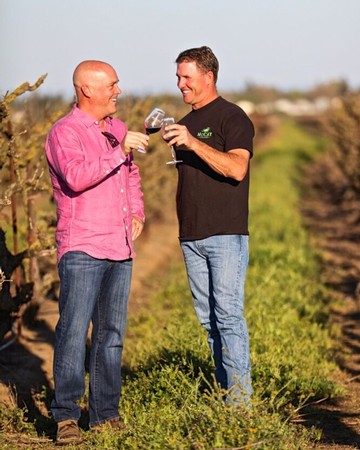
Mike McCay and Keith Watts saluting their winemaker/grower partnership in TruLux Vineyard
“This is also one of the first vineyards in the region to be certified with LODI RULES, which has been pretty rewarding. Herzog puts the LODI RULES seal on their label. The fruit goes to five different wineries – Michael David, Macchia, McCay, Macchia, and Watts. Mike McCay, who is a close friend of mine, is very passionate about the wine, and has done a lot for us by promoting the vineyard.
“100 tons or so are picked for our biggest buyer, Herzog Wine Cellars. It is crushed at a local winery (LangeTwins Family) and trucked down in tankards to their winery in Oxnard. Their wine is flash pasteurized (part of Herzog’s kosher protocols), and is value priced for larger markets. Picking for them can be a little challenging because they have special holidays, but each year we get it done.”
2014 McCay Cellars, TruLux Vineyard Mokelumne River-Lodi Zinfandel ($32) – Cola berry fruit nose embellished with pungent sweet peppercorn/brown spice with undertones of loamy earth; firm yet fleshy medium-full body with a well rounded feel, carrying the earthy/berry fruit into a savory finish.
2015 Baron Herzog, Lodi Zinfandel ($9.99) – More of a sculpted iteration of TruLux Vineyard; smoky, plummy/berry fruit in nose, becoming earthier in a round, easy-peasy, medium-full body marked by pliant tannin; finishing with smoky/tobacco notes.
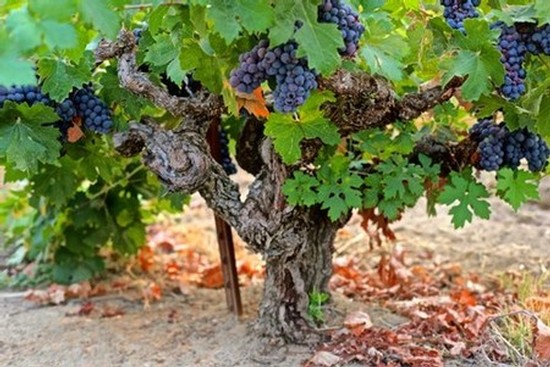
Süess Vineyard Zinfandel in Lodi's Clements Hills
Markus Bokisch (Bokisch Vineyards):
“I ‘discovered’ Lodi in the late 1980s; realizing this was a very unique community, after living and working in Napa Valley. Today we are a farm management company, farming 2,800 acres of wine grapes in 4 different counties of California. Our winery produces about 5,000 cases.
“We grow all the important grapes, but we came to Lodi to specialize in Iberian varieties. A few years ago, a good friend by the name of Tegan (Passalacqua) asked, ‘Why aren’t you making a Zinfandel?’ I said, ‘Well, that’s not really my story.’ But when I thought about it, I realized Zinfandel really is part of my story; at least for my children, who grew up in Lodi. So we now farm 87 acres of Zinfandel, all within the larger Lodi AVA, in 4 different vineyards – two of them younger vines on wire, and two older, head trained vineyards. Neyers Vineyards in Napa Valley is one of the wineries purchasing fruit from Vista Luna Vineyard, which is on wire. The other wine we are showing is from Süess Vineyard; an older planting, about 95 years old.
“Early on, I realized how important branding is. Whenever we developed a vineyard, we would immediately give it a name. The Vista Luna Vineyard got its name somewhat haphazardly. It used to be an apple orchard, which I never thought it should have been, and I had been waiting and waiting for the opportunity to buy it. I remember the night we finally closed on the property. We drove out there with a bottle of California sparkling wine, and sat on the tailgate drinking it. It was dusk, and up came a beautiful full moon. So we said, this is the ‘Vista Luna Vineyard,’ and that was that.
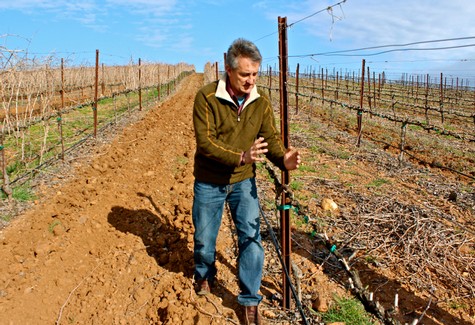
Markus Bokisch in his Vista Luna Vineyard Zinfandel planting just prior to modifying trellises with cross-arms
“The name itself doesn’t get a vineyard sold. It takes a lot of elbow grease and right decisions to get it recognized. The first thing we do when selecting a site is look for the right soil, choose the right grapes and clones, and the right rootstocks. In the case of the Vista Luna Zinfandel, we chose a really vigorous rootstock (5BB) because the soils in Borden Ranch are so poor. The whole purpose is to take advantage of a site. We originally decided on 9’ by 6’ spacing and a modified VSP (vertical shoot positioning) trellis. We quickly found out that a straight VSP wasn’t going to work because, for Zinfandel, you really need to spread out the canopy to duplicate what you get in a head trained vine – lots of air space, and speckled light shining into the fruit zone. We put on cross-arms to achieve that spread-out structure to improve the fruit quality, and indeed it has really worked out well.
“Achieving fruit quality is also all about partnerships with your buyers. It’s important to invite them to come in and give you feedback. As growers, we all need larger wineries to survive, but those relationships can sometimes become antagonistic – prices aren’t good, tonnage not right, or they’re fighting for higher quality while there may not be enough money in the agreed-upon budget to work the vines to everyone’s satisfaction.
“Working with smaller, ultra-premium wineries is usually more of a pleasure because in this case you’re working in closer partnership – buyer and seller working towards a common goal, finding tweaks and improvements to implement in the vineyard. This involves a lot of conversation, and I feel we are still scratching the surface where this is concerned. We have a good idea of what Nyers Vineyards wants, for instance, because we’ve been working together for over 10 years – the 2017 is their tenth vintage of Vista Luna Zinfandel.
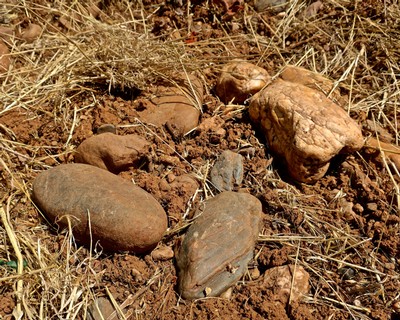
Cobble, rocks and clay soil typifying Lodi's Borden Ranch AVA among Vista Luna Vineyard Zinfandel vines
“From a branding perspective, it’s a tougher road when you’re dealing with a young vine planting like Vista Luna. All vineyards need to develop an identity, starting with a name. It continues with increasing the appreciation of the appellation, Borden Ranch, which has very unique volcanic soils. There are people out there seeking this. Vista Luna is also in LODI RULES, and that’s really important. The general consumer may not completely grasp the importance, but LODI RULES means a lot to the grape buyer, as it implies that the grower is really taking the time to achieve these high standards, which is not an easy bargain. In 2019 Vista Luna will also gain (CCOF) organic certification, which demands even more attention to detail.
“Süess Vineyard presents a different challenge as an old vine planting. The vineyard is leased from the Süess family, and is slightly different from other old vine vineyards in Lodi. Historically, it’s been dry farmed; but prior to our taking over, it was producing little more than a ton per acre and getting maybe only $450/ton. So it was on a quick race to the bottom.
“But I had known and loved this vineyard for a long time, and was aware of its pedigree in terms of potential wine quality. So we thought we’d take a shot. When we took over it was a 15-acre vineyard only in theory. It was more like a 12-acre vineyard because of all the misses (i.e. dead vine spots). We installed sub-surface irrigation and commenced a program of replanting.
“The vineyard was originally planted in the late 1920s on a slightly rolling hillside, in Tokay sandy loam – a completely different soil type from the rest of the Clements Hills, but typical of old vine Zinfandel throughout the Lodi appellation. The vineyard is on traditional 10’ by 10’ spacing for a potential of 455 vines per acre, although there were only about 350 vines to the acre before we kicked it up with young vines. There was also some very bad pruning going on previously, requiring a lot of reconfiguration of spur positions during the transition.
“As it now stands, about 75% of Süess consists of the original old vines on their own roots. About 10%-15% are 1960s replants on St. George (rootstock), and the balance is new vines planted over the past five years on 110R rootstock. For the new vines, we took cuttings from the original selections. The vineyard is currently in transition towards LODI RULES, which I think will interest buyers even more.
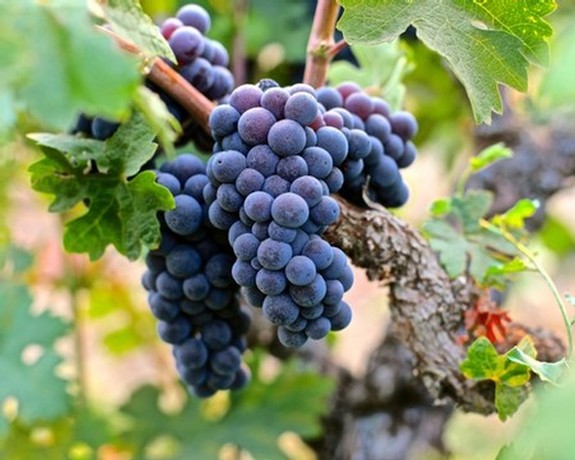
Süess Vineyard Zinfandel clusters
“As with all our vineyards, the goal is seeing these vineyards make money. We currently have a total of 7 buyers for Vista Luna Vineyard Zinfandel. To keep older plantings like Süess Vineyard in the ground, we figure that we’ll ultimately need to make 6,000 gross dollars to the acre, which we can then farm in sections to the specifications of individual buyers. Big buyers like Fetzer Vineyards pay far less than that; but on the balance, our Zinfandel plantings go for $1,100 to $1,700 a ton based upon a sliding scale of how much fruit is preferred. I’d say that, for now, we are getting a minimum, on average, of what is needed to farm these vineyards, and justify their existence.
“We should be able to reach our goals by transitioning more and more to the ultra-premium segment of the Zinfandel market. Besides, it’s much more intellectually stimulating for us to form relationships with people who are willing to walk these vineyards frequently and work hand-in-hand with us to improve performance. It’s also ultimately more sustainable for the vineyard itself when you’re not constantly trying to increase tonnage to improve revenue. For all the work put into it, we’ve only recently have been able to get Süess up from 1 ton to 2.5 tons per acre.
“Of all our vineyards, Süess is also the only one that tends to have a tremendous amount of acid. More often than not, picking decisions are made based upon waiting for acids to drop rather than sugars to rise. That’s a positive, because it creates clean, fresh fruit. On the negative side, the vineyard is surrounded on two sides by walnut orchards, and birds love to sit in walnut orchards. And so, we not only have to wait for acidity to drop, but while the grapes’ sugars are climbing the birds are waiting things out, too. Consequently, we tend to have to do a pretty aggressive fruit-thin on both the east and west flanks of the vineyard to take out all the bird damage, which cause potential infections. This only decreases yields, which are already low.
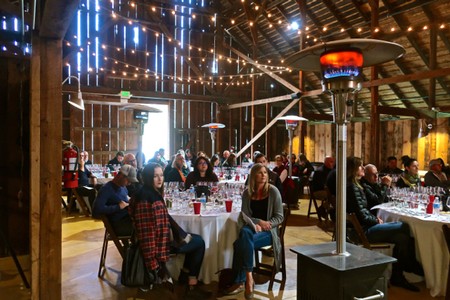
Vintners and growers during National Zinfandel Day Technical Workshop
“Neyers, and most of our other wineries, tend to prefer their Zinfandel picked at lower sugars and higher acids because as a group they tend to not want to do any acid or water additions. If you properly crop and bring your fruit in earlier, you can maintain that quality objective. Vista Luna Zinfandel harvests are often called on acid levels, and grapes are picked at 23.5° to 24.5° (Brix) sugars at the most. These moderate sugars are more difficult to attain in Süess Vineyard, where waiting for acids to drop can lead to higher sugars, which is exacerbated by sudden heat spells like what we got in 2015.”
2017 Neyers Vineyards, Vista Luna Vineyard Borden Ranch-Lodi Zinfandel ($26) – Fresh, airy, bright black cherry fragrance with sense of purity, unfettered by external qualities like oak; firm, zippy, medium body with real sense of moderation and brightness.
2015 Tizona (by Bokisch Vineyards), Süess Vineyard Clements Hills-Lodi Zinfandel ($29) – Picked at 27° Brix and finished at 15.6% alcohol, yet possessing a spare, lanky, almost delicate feel absolutely belying the numbers; flowery, compelling red cherry fruit in the nose and zippy, mouth-watering sensations.
Winemakers' Perspectives: Defining Their Role In the Future of Lodi Zinfandel
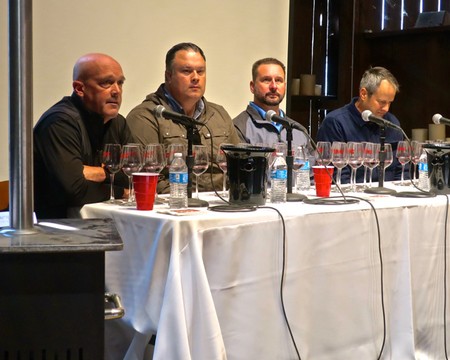
Winemaker panel (from left): Mike McCay (McCay Cellars), Tegan Passalacqua (Turley Wine Cellars), Derek Devries (Michael David Winery) and Chad Joseph (Joseph Wine Works)
Chad Joseph (Joseph Wine Works; including Harney Lane Winery & Oak Farm Vineyards):
“I am a winemaking consultant and contract winemaker – my company is called Joseph Wine Works. My first job as a winemaker in the mid-‘90s was at E. & J. Gallo in Modesto, and it was my first introduction to Zinfandel coming in from the Lodi region. At Gallo I saw all these amazing, beautiful lots coming in, and had the opportunity to taste them before they all disappeared into giant sized tanks, or were turned into White Zinfandel. I was smitten by Zinfandel, and so when I finally decided to leave E. & J. Gallo Lodi was the logical place to relocate.
“When I first arrived in Lodi I was taken aback by the people as much as Zinfandel; especially the growers, who I found to be entrenched in their passion for growing the grape. In my various winemaking consulting jobs I have developed a growing appreciation for just how diverse these vineyards are, and how capable they are of creating a diversity of wine styles. Most recently, we have begun focusing more on wines that showcase vineyards, not just the grape; developing the tastes of each vineyard, learning how to market them and deliver that to the consumer.
“As Bruce (Fry) and Markus (Bokisch) have pointed out, in our own branding we are working to bring out the flavors and terroirs of each of these vineyards. I believe this will be the key to the future moving forward. We have found that certain vineyards lend themselves to certain styles. A lot of our progress has come from following protocols set by the Lodi Native project, which highlight the characteristics of individual vineyards. We’ve learned to apply these principles to wines like Harney Lane Winery’s Lizzy James vineyard-designate Zinfandel. Over the years we’ve learned more of the right approaches to this vineyard – through native yeast fermentation, maybe lower Brix at harvest, plus all the little things that bring out the characteristics that make Lizzy James what it is. For other vineyards, it might involve more hang time and fruit concentration, or slightly different steps in the winery to get fruit expressions that are different – whatever is appropriate for each vineyard.
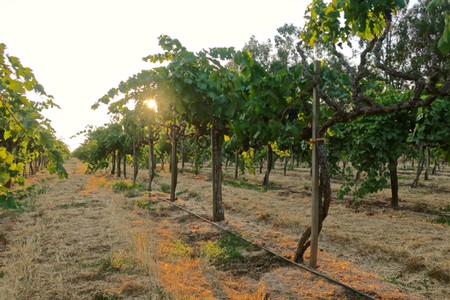
Trellised Zinfandel, about 55 years old, in Hohenrieder Vineyard in Lodi's Jahant AVA
“The Hohenrieder Vineyard that we are showing was planted in the 1960s; planted on Freedom rootstock, and in the past, it was primarily used for White Zinfandel. For the portion we use for a single-vineyard wine, we have been paying the grower by the acre rather than by the ton so that we can have it farmed in a way that produces the quality we want. In the Hohenrieder Zinfandel, you find a good ripeness along with interesting eucalyptus and spice notes unique to this vineyard.
“The Scottsdale Vineyard – named after the road the vineyard is located on – is farmed by Kyle Lerner, who owns Harney Lane Winery. It’s only two and a half acres and represents a relic of a once-larger vineyard that previously went to big wineries. Kyle farmed it for years before getting the opportunity to buy the property. The cool thing about the vineyard is that it’s located close to Marian’s Vineyard and shares a similar type of Tokay fine sandy loam, unique to that part of the Mokelumne River AVA, south of (the City of) Lodi. What’s interesting is we do both native yeast and inoculated fermentations. The native ferments give us a kind of earthy loamy flavor typical of west size Zinfandels, while the inoculated ferments gives us that bright, perfumed fruit quality typical of east side Zinfandels.”
2017 Oak Farm Vineyards, Hohenrieder Vineyard Jahant-Lodi Zinfandel ($35) – Almost a cacophony of exuberant, if partially peculiar (in a positive sense), aromas – sweet berry perfume laced with herbal/leafy/minty and eucalyptus notes – all contained in a lean, zesty, medium-full body, finishing with an edgy, refreshing, lip smacking quality.
2016 Harney Lane Winery, Scottsdale Vineyard Mokelumne River-Lodi Zinfandel ($36) – Beautiful harmony of aromas – bright blueberry, quieter notes of raspberry/cherry and floral/violet qualities tinged with sweet oak tones – evolving into a svelte, rounded, medium-full body, with a subtle scintilla of loamy earthiness popping up in the finish.
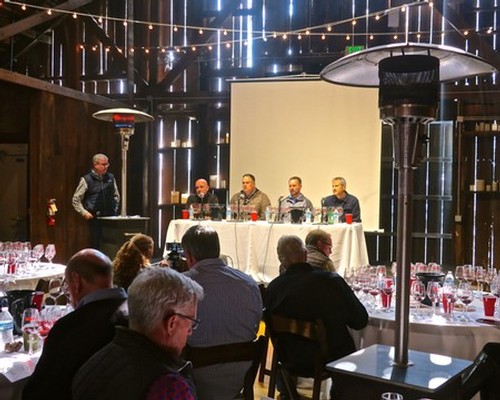
Mike McCay (McCay Cellars):
“We are family winery, started in 2007, and right now we’re at about 4,500 cases. Zinfandel is a big passion for us. The goal is to find these hidden gems – the vineyards that have long been ‘disappeared’ into giant vats and jug wines – throughout the appellation. One of the wines I am showing today is a 2015 from a vineyard (Bonnotto) that was produced and bottled that year for the first time in its long history, dating back to the 1930s.
“As Bruce Fry mentioned, we strongly encourage growers to help us identify these special vineyards. There are probably many more on both the east and west sides of Lodi that are out there, waiting to be ‘discovered.’ There are many reasons to take pride in the vineyards that we have; especially since I know that there are many winemakers who can’t wait to get their hands on them.
“Driving around the region over the past few weeks, I don’t recall seeing as many vineyards that have just been pulled up; piles and piles of old wood, ready to be hauled away. A good percentage of these are old vine Zinfandels. Lodi is a great place to be, but we still need to talk more about the ongoing loss of these old vines. Increasing the production of vineyard-designate wines may be the most important thing we can do to prevent that; and as a winery, we are doing our best to be part of it.
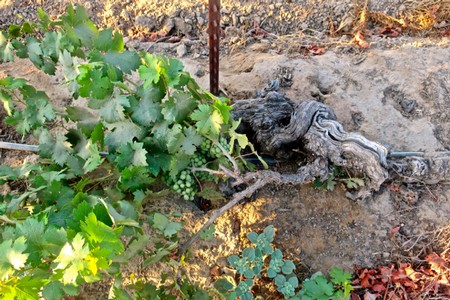
Prostrate vine (one of the hazards of old age!) in Lot 13 Vineyard on Lodi's east side
“For those of you less familiar with Lodi Native, which Chad talked about, this project started out in 2012 with six winemakers getting together to agree on following the same winemaking protocols basically taking away the usual tools of the trade: no inoculation, no adjustments, no new oak – basically, crushing grapes, fermenting on native yeast, and putting the result in the bottle as-is. The goal, pure and simple, has been to showcase Lodi vineyards.
“Each year we’ve ended up with six different vineyards made by six winemakers; and when you tasted each Lodi Native wine, you get distinct flavors along with common threads. One of the basic distinctions has involved vineyards on the west side of Lodi, versus vineyards on the east side. West side vineyards produce slightly bigger, riper, jammier styles of Zinfandel. On the east side, we get more florals, prettier, redder and bright fruit qualities. Before the Lodi Native project, most people thought of Lodi as being generally flat, and not capable of producing different styles. Our entire goal has been to demonstrate that that’s just not the case. Lodi Zinfandel can produce many different styles depending upon where it’s grown; not just depending upon who’s doing the winemaking.
“The first wine that I’m presenting is just that: a Lodi Native from a vineyard on the east side called Lot 13. The name comes from an original colonial map of the vineyard blocks from 1906, which marked this vineyard as Lot 13. To me, this is a true representation of Lodi’s east side Zinfandels, with its brighter, more floral style of fruit. I usually start with a pick at around 23.5° Brix with a little more acid, followed by second or third picks at a little higher sugar. All the lots go into either in a Lodi Native or a McCay label Zinfandel called Faith.
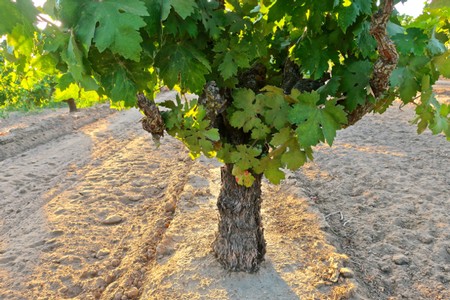
Old vine and Tokay fine sandy loam in west side Lodi's Bonnotto Vineyard
“Lot 13 also demonstrates the characteristics of a smaller part of the east side which has been called the ‘Victor Triangle’ (in reference to the little CDP of Victor sitting at the approximate center). We’re in one corner of the Victor Triangle surrounded on three sides by the Mokelumne River, which I like to call ‘The Peninsula.’
“The second wine I am presenting is bottled under the McCay label as Bonnotto Vineyards, a vineyard located on Lodi’s west side. According to Vince Bonnotto of the Bonnotto family, this vineyard was originally planted in the 1930s on its own roots by one of the branches of the Spenker family. It’s about 20 acres, and represents a west side Lodi Zinfandel; meaning, it’s a little bigger style of Zinfandel, with darker fruit – going more towards blackberry than cherry – and a much rounder, fuller feel. You can talk about round pegs going into round holes: the idea is to not try to turn a Zinfandel into what it is not. To try to push a Bonnotto into being more of a floral, delicate style of Zinfandel just doesn’t make sense; whereas a Lot 13 fits that style very easily.”
2015 Lodi Native (by McCay Cellars), Lot 13 Vineyard Mokelumne River-Lodi Zinfandel ($35) – Picked at 23.3° and finishing at 13.8% alcohol; flowery, ultra-intense, red cherry perfume tinged with peppercorn/clove spice, billowing from the glass; medium-weight, slender, rather feminine, zesty feel; the fruit qualities remaining lithe and lissome as the wine skips across the palate.
2015 McCay Cellars, Bonnotto Vineyard, Mokelumne River-Lodi Zinfandel ($32) – Picked at 24.1° Brix and finished at 14.4% alcohol; in almost stark contrast to McCay’s Lot 13, a deeper, darker, fuller bodied, more broadly textured wine, more aromatic than perfumed; yet far from over-the-top in its rounded, balanced feel; the earthy/forest floor-like notes not uncommon to west side Lodi Zinfandels mingling with the dark berry qualities in the finish.
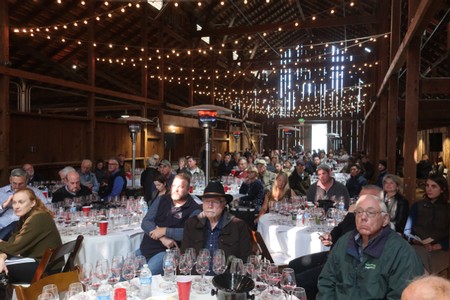
Derek Devries (Michael David Winery:
“I’ve been working as a winemaker in Lodi since 2004. Zinfandel was the primary driver in my decision to come to Lodi. Phillips Farms farms about 700 acres of their own vineyards, and works with over 25 other growers of Lodi Zinfandel. Michael David Winery’s current Zinfandel book includes a $60 Lust, and premium level Zinfandels in our Earthquake and Freakshow series.
“The way we make wine at Michael David can be described as “big” – big fruit to express the region. One of the unique things we can do comes from having all the tank space we need. We are able to ferment all the individual vineyards farmed by our numerous growers separately. We don’t have to make picking decisions earlier or later than what we want.
“This also gives us the freedom to freely make our blends. By working with both east side and west side fruit, we are able see the distinct differences and then use that to our advantage. Often, by blending the characteristics together like we do in our Earthquake series wines, we find that the different vineyards can make a very nice match, and balance each other out even in the bigger styles we try to achieve.
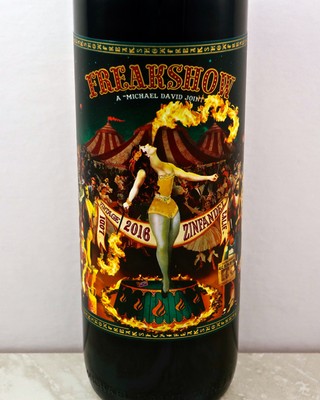
“Freakshow is an earlier picked style; more fruit forward than the Earthquake series zins. It sees about 10% new oak, and the rest is neutral. Earthquake, by way of contrast, sees more medium-plus toast – a more robust oak flavor, 47% new in the 2015. Of all the varieties that work with Zinfandel as blenders, I like Petite Sirah and Petit Verdot best. Freakshow is 87% Zinfandel, and Earthquake about 77%. These percentages vary from vintage to vintage, and we maintain the consistency of style we are looking for by following certain winemaking protocols developed over the years.”
2016 Freakshow (by Michael David Winery), Lodi Zinfandel ($20) – Consisting primarily of two components: 48% Joe Peterson’s vineyard on Alpine Rd. (east side Lodi) and 19% from the Soucie Vineyard on W. Turner Rd. (west side). Unrepentantly big, ripe, jammy varietal profile in the nose and palate; yet with a sense of moderation – driven by zesty edged acidity and judicious tannin – in its somewhat sinewy medium-full body, with black cherry/blackberry fruit qualities rising to the top.
2015 Earthquake (by Michael David Winery), Lodi Zinfandel ($26) - Primarily from four Lodi growers (about 12% each): Joe Peterson’s on Alpine Rd.; Jon Graffigna Jr.’s on Jahant Rd.; LangeTwins Family’s on W. Turner Rd.; and Phillips Farms’ Woodbridge North Block. Ripe, aggressive nose of sweet/plummy fruit and smoky/toasty oak framed sensations in the nose and a full, firm, robustly sculpted body.
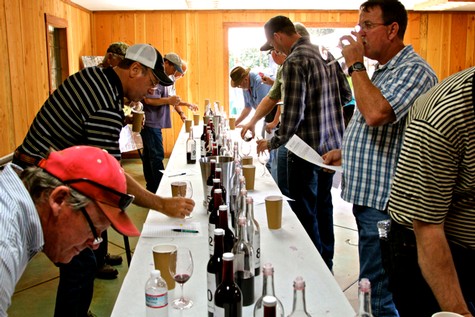
Michael David Winery's Zinfandel growers tasting, assessing and rating their own barrel lots
Tegan Passalacqua (Turley Wine Cellars):
“As Director of Winemaking at Turley Wine Cellars, we work with about 50 vineyards throughout the state and produce Zinfandel in three winery locations – in St. Helena (Napa Valley), Paso Robles, and the Sierra Foothills.
“We work with 7 vineyards in Lodi alone. We’re proud of that. The Dogtown Vineyard Zinfandel we’re pouring today is actually a celebratory vintage; representing the 20th vintage bottled by Turley from Dogtown as a vineyard-designate wine.
“Turley first came to Lodi when Markus Bokisch brought our attention to an old vine planting (owned by what is now Jessie’s Grove Winery) that was in the process of being ripped out. We were told, ‘Well, we can’t get enough money for it.’ Markus said, ‘What if I found somebody willing to pay for it?’ I wasn’t with Turley at the time, but I believe we paid about $1,200 a ton for it – and that was back in 1996. So if anyone asks me what they should be paying for old vine Lodi Zinfandel today, I say, ‘definitely over $1,200/ton,’ although I actually believe the current value of old vine Zinfandel in Lodi should be closer to $4,000/ton.
“From the perspective of a winery that works with vineyards in 14 different counties, I can say that Lodi is a true treasure trove of old vine Zinfandel. Yet the first rule of sustainability is that you’ve got to make a nickel. Lodi’s farmers have set things up perfectly by farming their vineyards very well. But we romantic winemakers who want the highest quality crop from stressed vines probably still aren’t paying a fair price for those grapes.
“Turley has been out here in Lodi for 22 years. We just signed another 16-year leas on the Dogtown vineyard out in Clements Hills, and we’ve recently leased an old vine vineyard from the Steacy sisters out near Acampo – a site with 8 of its acres planted in 1907, which I believe makes it the oldest vineyard in Lodi planted on St. George rootstock.
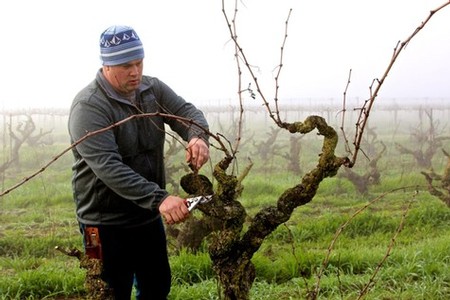
Tegan Passalacqua pruning his Kirschenmann Vineyard
“Kirschenmann (located alongside McCay’s Lot 13 Vineyard) is a 20-acre vineyard; 15 of those acres planted in 1915. I was first attracted to this part of Lodi in 2004, when Markus Bokisch introduced me to (the late) Ross Schmiedt. In 2008 we (Turley Wine Cellars) started buying grapes from Ross’s Dairy Vineyard (located on between the Mokelumne River and McCay’s Lot 13 block). The first time I tried the Zinfandel from that vineyard, which we’ve been calling Schmiedt Ranch, I thought I’d never had a wine like that before – a Zinfandel that was so perfumed and floral.
“Keep in mind that all the wines at Turley are made the same way. We don’t do tricks, no enzymes or saignée (i.e. “bleeding” of liquid from tanks to concentrate red wine musts), just cold soak and native yeast fermentation. We don’t adjust acid or adjust with water. We don’t fine, we don’t filter; so what you see is what you get. I was already a fan of Lodi style Zinfandel, but I immediately fell in love with what we were getting from Schmiedt Ranch in particular.
“I truly believe the area where Schmiedt and Kirschenmann are located is one of California’s special places for Zinfandel. I think there are 12 or more other exceptional vineyards in that little area extending across E. Hwy. 12 (Victor Rd.) planted between 1909 and 1919, which I have a feeling is not really a coincidence. Why are there so many pre-Prohibition vineyards in one place? The reason is because many wineries have wanted these grapes, and even in down times during recent history these vineyards managed to stay in the ground. It’s because this is a special place to grow Zinfandel.
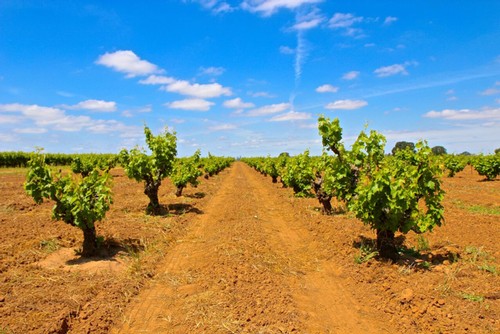
In Clements Hills' Dogtown Vineyard, "miniature" 74-year-old Zinfandel growing in site's uniquely sandy yet iron-rich soil
“The Dogtown is a Clements Hills vineyard planted in 1944, planted by a cousin of Ken Deaver’s, who grows grapes in Amador County. So I describe it as a Lodi vineyard planted by people from the Foothills. It has been dry farmed from the beginning, and is Turley’s lowest yielding vineyard-designate – no more than half a ton an acre each year. The vines are small; but if you see the vines, they are not stunted because of any disease. It’s just that, on this site, everything is sort of “miniature” – clusters are small, more like Pinot noir. The vineyard is healthy but tough to work with. It’s similar to Jeff Perlegos’ Stampede Vineyard in that it’s sort of a ‘tweener, making a wine that's somewhere between a Foothills style and a Lodi style. There is a little more iron in the soil, giving the wines more tannin and acid structure than typical Lodi Zinfandels, even with its sandy soils.
“If you’re selling a wine like Zinfandel, honestly, I don’t think price per ton matters as much as many people would lead you to believe. Because Dogtown gives only so much tonnage, it made sense for us to sign a long-term lease on the entire vineyard rather than negotiate an acceptable price per ton. But even if farming Dogtown costs us the equivalent of, say, $3,000/ton, we still make plenty of money selling the wine.”
2016 Turley Wine Cellars, Kirschenmann Vineyard Mokelumne River-Lodi Zinfandel ($35) – Super-bright, flowery, almost ethereal cherry perfume tinged with barest whiffs of kitchen spice; zesty medium-full body showing off the fruit qualities with a silky, layered feel punctuated by deftly rounded yet supportive tannin.
2016 Turley Wine Cellars, Dogtown Vineyard Clements Hills-Lodi Zinfandel ($38) – A blacker cherry aroma with a fragrant quality; definitively zesty acid edge in tune with moderate yet firming, sturdy tannin, carrying the bright cherry fruit qualities into a long, savory finish.
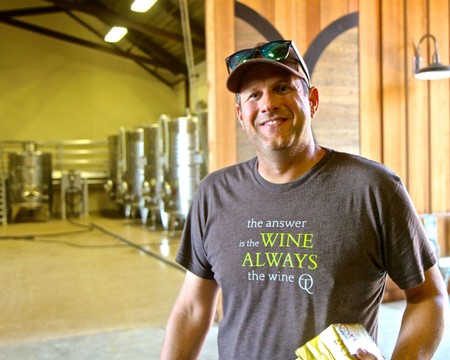
Winemaker Chad Joseph in Oak Farm Vineyards winery
Further Conversations
Stuart Spencer: “How would you describe the ‘signature’ style of Zinfandel grown in Lodi?”
Chad Joseph: “Zinfandel has been described as ‘America’s grape.’ It’s also a good grape for the American consumer because it can make a good, soft, richly flavorful varietal red. If that’s the case, Lodi Zinfandels may be the most ‘American’ varietal of all because it has that richness as well as a unique approachability, moreso than Zinfandels from other regions. The fruit qualities of Lodi’s Zinfandels are naturally pleasing and perfumed, yet as deep as any other.”
Tegan Passalacqua: “To me, a lot of Lodi Zinfandel’s ‘signature’ comes from the sandy soils, which offer a lot of texture that people in Sonoma and Napa can only dream of. There are real suave tannins that roll over the palate in Lodi Zinfandels. They are never really aggressive wines, but they can be sturdy. We had a ’98 Dogtown for dinner just last night that was showing really well as a 28-year-old Lodi Zinfandel, with no real signs of slowing down. Not only can these wines age, they are also approachable when young, which has been one of the keys to the success for Lodi Zinfandel. It’s great that you can pull a Lodi Zinfandel off a shelf and have a great experience of it that night.
“If anything, I think people need to recognize that the best wines in the world tend to be, for the most part, the opposite of manipulated. They’re not done in a chosen style picked at really high sugars for maximum flavor, then with added acid for freshness and oak chips for deeper flavor. If you travel around the world and see the wines that are making lesser known regions rise up and finally be counted, these are movements associated with wines made more in a natural style that let wines and vineyards speak. I think this is the style that best showcases regions; led by winemakers who take a hands-off approach, while always knowing when to step in.”
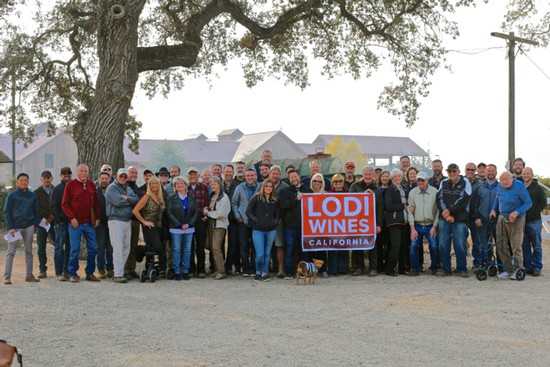
Growers and vintners gathered together for National Zinfandel Day Technical Workshop at Oak Farm Vineyards
Stuart Spencer: “What do you see are the opportunities for Lodi Zinfandel in the market today?”
Mike McCay: “We’re a small family winery, selling a wide range of varietals; but if anything, we’ve seen our Zinfandel sales only continue to rise. Based upon our experience, it’s been a matter of building on the uniqueness of vineyard selections, applying our hands-off style of winemaking to bring out each vineyard’s own textures and flavors. When people get a chance to taste that, they get very excited. Our small production Zinfandels are constantly selling out. This can be a negative, but I’m okay with that. It makes me very optimistic about the prospects of Lodi Zinfandel in the market.”
Chad Joseph: “To me, it’s all about education – events like this workshop, or what ZAP is constantly trying to do to reach the consumer. Once consumers are better able to understand what treasures these old vine Zinfandels really are, then they are willing to spend more for the premium bottlings – those unique $35 Zinfandels. That upgrade is bound to swing back to the growers, but it’s a matter of getting these products out front and center in front of the consumers. It’s this kind of success that’s going to play a part in keeping these old vine vineyards in the ground.”
Tegan Passalacqua: “We are seeing more and more markets across the country fall in love with Zinfandel. The markets that have historically been lukewarm to the idea of Zinfandel – in Los Angeles, New York, or San Francisco – are also finally starting to fall in place, particularly the higher-end consumers. There is, for example, a new wine critic for The Wine Advocate (published by the influential wine critic, Robert Parker) who recently came by and tasted our wines – a guy who knows Burgundy better than I know. He was asking the question, ‘Is Zinfandel the most transparent grape grown?’, which started a great conversation. It brought out the fact that Zinfandel has the potential of showing site-specific qualities that other varieties can’t. Moving forward, I think that’s what everyone will be after. You don’t want to use valuable old vine vineyards to produce mass-produced wine, because that would be quick race to the bottom.
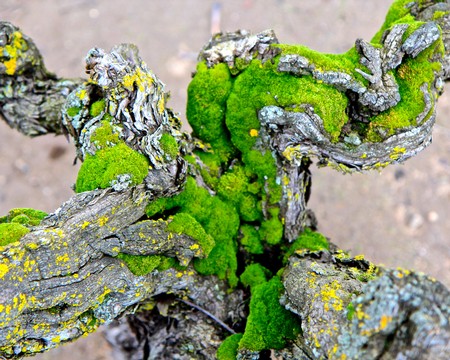
Over 100 years of moss and lichen growing on ancient vine Zinfandel in Lodi's Soucie Vineyard
“We already know that countries like Chile, Argentina and South Africa can beat us with labor all day long. There are other great places to grow grapes, but if you’re just going with the lowest common denominator, there are other wine regions that can more than compete with us. In the future we’ll be paying our workers more than before, but this would be for the common good. We’ve already seen where pickers have stopped working in the middle of a harvest to re-negotiate price. It’s something new, but something we’ll have to expect more of.
“As it was brought up earlier, I think the future will be all about increased diversity of styles. I think younger people look upon Zinfandels from the ‘80s and ‘90s as their parents’ styles. Zinfandels like Maître de Chai, made by Alex (Pitts) and Marty (Winters), are good examples of something more appealing to youth. The more diversity of Zinfandel styles we see, the more we’ll be able to attract younger generation drinkers.”
Stuart Spencer: “Any last thoughts on where Lodi Zinfandel is going?”
Mike McCay: “We already know that Lodi Zinfandel is huge from a standpoint of demand. For me, it’s all about old vines – the youngest vineyard-designate Zinfandels that we do are about 80 years old. It breaks your heart to see an old vine pulled out, but the ones that survive will remain part of a place where you can still say, ‘these are the best old vines in the world.’ But as I’ve heard Chad Joseph once say, once you pull out an old vine Zinfandel you can’t put it back in. When exactly we’ll be reaching a point where old vine Lodi vineyards are worth a lot more money, I don’t really know. But in the meantime, our job will be to continue showing off the uniqueness of these vineyards – marketing them, branding them, and telling people, ‘Hey, we’ve got something special you can’t find anywhere else.’ And take pride in that!”
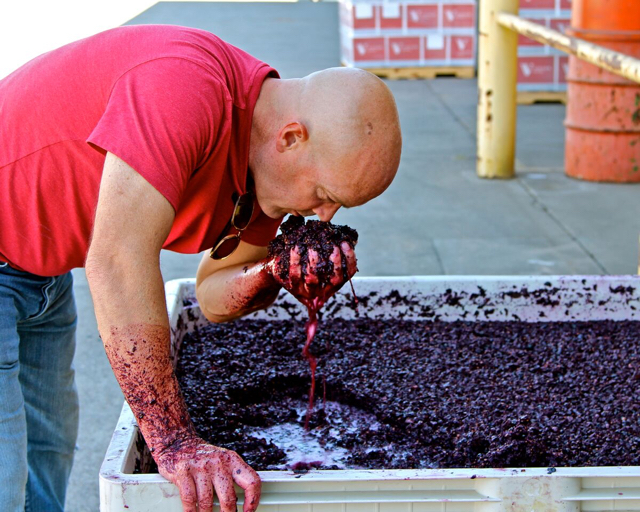
McCay Cellars' Mike McCay doing his thing
Tegan Passalacqua: “I think one of the bigger issues is growers with large plots of Zinfandel, accustomed to selling 200 tons at a time at a time when there are fewer and fewer takers. If you look at the history of the grape in the state, you see that at one time there were many more Zinfandel vineyards that at one time were a lot bigger. What happened is most of them went out, but growers kept their best 10 or so acres. I think more vineyards will be pushed out in Lodi, but if you’re a grower I’d say, ‘keep your best 10 acres.’ There will come a time when it will be in great demand.
“When you look at Napa Valley, the average price of mediocre Zinfandel today is $4,000 a ton. Yet we can come out here to Lodi for Zinfandel at $1,500 a ton, which I would argue is of much higher quality all day long. The price of Lodi Zinfandel grapes will be going up; a lot of that, because of the vacuum already created by Napa and Sonoma. But you just have to be patient and keep your best plots in the ground, realizing that at one point people will come knocking.”
Chad Joseph: “I hope we don’t have to lose many more of these amazing old vines; but given the economics of it all, many of these vineyards will be coming out, and many of them will stay – and in the future, only become more desirable. As of now, there is an over-supply of vineyards for red Zinfandel. But vineyards like Lizzy James and Scottsdale, they’re not going anywhere. So with the vineyards we manage to save, and continue to do our branding and our vineyard-designates, I say, ‘keep it up, and don’t give up!’”
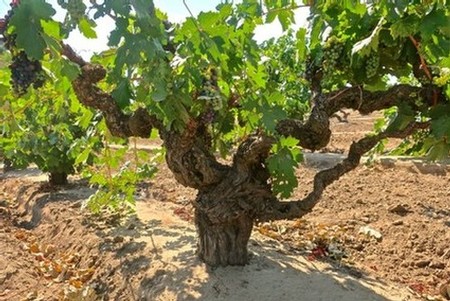
Harney Lane Winery's Scottsdale Vineyard